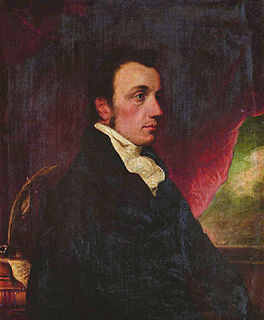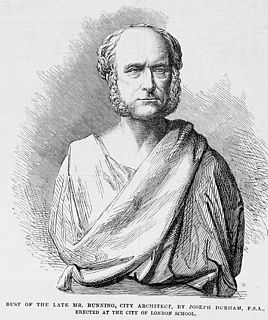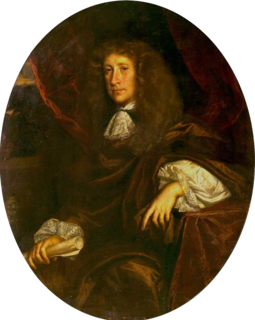
Middlesex is a historic county in southeast England. Its area is almost entirely within the wider urbanised area of London and mostly within the ceremonial county of Greater London, with small sections in neighbouring ceremonial counties. It was established in the Anglo-Saxon period from the territory of the Middle Saxons, and existed as an official administrative unit until 1965. The county is bounded to the south by the River Thames, and has the rivers Colne and Lea and a ridge of hills forming its other boundaries. The largely low-lying county, dominated by clay in its north and alluvium on gravel in its south, was the second smallest by area in 1831.

Edward Foss was an English lawyer and biographer. He became a solicitor, and on his retirement from practice in 1840, devoted himself to the study of legal antiquities. His Judges of England was regarded as a standard work, characterized by accuracy and extensive research. Biographia Juridica, a Biographical Dictionary of English Judges, appeared shortly after his death.

Henry Wheaton was a United States lawyer, jurist and diplomat. He was the third reporter of decisions for the United States Supreme Court, the first U.S. minister to Denmark, and the second U.S. minister to Prussia.

William Borlase, Cornish antiquary, geologist and naturalist. From 1722, he was Rector of Ludgvan, Cornwall, where he died. He is remembered for his works The Antiquities of Cornwall and The Natural History of Cornwall (1758), although his plans for a parish-by-parish county history were abandoned.
Richard Burn was an English legal writer.

Bruce Castle is a Grade I listed 16th-century manor house in Lordship Lane, Tottenham, London. It is named after the House of Bruce who formerly owned the land on which it is built. Believed to stand on the site of an earlier building, about which little is known, the current house is one of the oldest surviving English brick houses. It was remodelled in the 17th, 18th and 19th centuries.
Stoke Newington was an ancient parish in the county of Middlesex. It was both a civil parish, used for administrative purposes, and an ecclesiastical parish of the Church of England.

Edmonton is one of six hundreds of the historic county of Middlesex, England. A rotated L-shape, its area has been in the south and east firmly part of the urban growth of London. Since the 1965 formation of London boroughs it mainly corresponds to the London Boroughs of Enfield, a negligible portion of Barnet and a narrow majority of Haringey. Its ancient parish of South Mimms has since 1965 been part of the Hertsmere district in Hertfordshire.

All Saints' Church, Edmonton, is located in Church Street Edmonton, London, England. First recorded in the 12th century, it was entirely rebuilt in the 15th century and has undergone many modifications since.
Sir Thomas Frowyk KS was an English justice.
Samuel Clapham (1755–1830) was a clergyman of the Church of England, a justice of the peace, and a writer. His best known work, the collection Practical Sermons on Several Important Subjects, published under the pseudonym Theophilus St. John, went through four editions.

The Liberty of Glasshouse Yard was an extra-parochial liberty adjacent to the City of London. The liberty took its name from a glass manufacturing works established there. The area now forms part of the London Borough of Islington.
John Frederick Archbold (1785–1870) was a barrister and legal writer. He was the first editor of the English criminal law textbook Archbold Criminal Pleading, Evidence and Practice, which is still routinely used in court today.

James Bunstone Bunning was a British architect. He held the post of architect to the City of London from 1843 until his death, and is probably best remembered for his design for the Coal Exchange.

Sir Hugh Smithson, 1st Baronet of Stanwick St John, North Yorkshire, was a Royalist supporter during the Civil War for which he was rewarded with a baronetcy by King Charles II on the Restoration of the Monarchy in 1660. His great-great-grandson was Sir Hugh Smithson, 4th Baronet (1715-1786), who having inherited by his marriage half of the great Percy, Earl of Northumberland, estates, and the title 2nd Earl of Northumberland by special remainder from his father-in-law Algernon Seymour, 7th Duke of Somerset (d.1750), changed his surname and arms to Percy and was created in 1766 1st Duke of Northumberland.
William Dickinson (1756–1822) was an English topographer and legal writer.
Joseph Merceron (1764–1839) was a British businessman, property developer, parochial politician and magistrate notorious for his corrupt practices.

Sir David Hechstetter was a director of the Company of Merchant Adventurers of London and a land-owner in Hertfordshire and Middlesex. He was a justice of the peace for Middlesex and was knighted in 1714.

Thomas Staveley was a Stuart antiquary, magistrate, anti-Papist, and Church historian. He spent most of his life researching the antiquities of his home county, Leicestershire.












